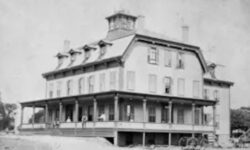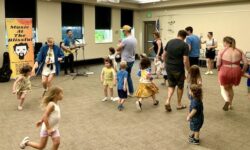Photo by Isabell Macrina
Going all the way back to the Egyptians with why we bury our dead. We leave them with what they will need in the next world
By Isabell Macrina
Hometown Weekly Reporter
Walpole Public Library started the fall season off with a spooky presentation, Welcome to The Graveyard featuring the Gravestone Girls. Brenda Sullivan of the Gravestone Girls joined the people at WPL to educate on the history of New England Cemeteries.
The goal of Gravestone Girls is to “keep our dead alive” by preserving cemeteries’ art and history. Sullivan broke down history into three main eras; Colonial from 1600-1700, Rural Garden in the 1800s, and Modern which is from 1900 to the present. Sullivan went around Walpole earlier that day to find local examples of each, bringing history a little closer to home.
Sullivan started by discussing the ever-changing colonial landscape of burials. In that era, people were buried with a headstone and a footstone, everything was done in pairs at the height of the person. The writing on each faced west and the person faced east, that way when they were summoned for Judgement day they could get out and walk the right way. Gravestones at this time were made with Slate, they had to use whatever material was readily available, and decorated typically with icons of Death’s Head (winged skulls) or the Winged Soul (a face with wings). These were not done in a particular likeness to the deceased, they were meant to symbolize being human and the spirit makes its ascent into heaven; what lies below is just the bones.
The Rural Garden Era inspired more natural landscaping around the graveyards. Rather than it just being the gravestones, there were trees, flowers, and overall flora added to the graveyards to make it more welcoming. This also brought the rise to family plots; people would buy a plot of land for the family to be buried together. The plots together formed a sort of neighborhood, Sullivan joked, and people would picnic here to connect.
The modern era is where our view of humanity and mortality differs from the past. Death used to be more personal, it would happen in the home, and the family prepared the body. Nowadays it happens in a facility like a hospital, and with medicine we have pushed death farther out of our minds. Naturally, we feel a disconnect between death and ourselves. Cemeteries became spaces we don’t visit often, and granite tombstones would share the name of the deceased and the dates but not much else; you could not meet the person like you could in the past. Since the 1980’s, we have gone back to “who we are and what we enjoyed” with practices like ceramic painting or etching into black granite. Even QR codes can take you to websites where they are memorialized. “I can see you,” Sullivan said. It is taking back the narrative to truly celebrate our dead.
Cemeteries are interesting places to explore, and the night ended with Sullivan encouraging the crowd to get out there and see what history is buried under our feet.






















